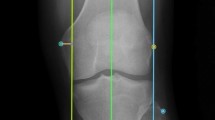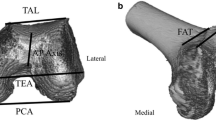Abstract.
The purpose of this research was to determine the significance of the transepicondylar line as a parameter of femoral axial alignment. Standing full-length X-ray films of 124 knees of 91 patients (63 women, 28 men) with osteoarthritis, rheumatoid arthritis, or osteonecrosis were used in this study, in which the lateral angles formed by the femoral anatomical axis intersecting with the transepicondylar line (angle a′), horizontal line (angle b′), and femoral condylar line (angle r′) were measured. The mean value of angle b′ in knees with neutral alignment was significantly smaller than that in knees with varus alignment, and significantly larger than that in knees with valgus alignment; no significant difference was found in angle a′. Also, there was no significant difference in angle a′ among the patients with osteoarthritis, rheumatoid arthritis, and osteonecrosis. These findings suggest that the transepicondylar line, which is a stable reference of femoral rotation, is also a very reliable parameter of axial alignment of the femur. In the future design of extramedullary guiding for total knee arthroplasty, the transepicondylar line may play an important role as a parameter for proper and accurate implant setting.
Similar content being viewed by others
Author information
Authors and Affiliations
Additional information
Received: October 4, 2000 / Accepted: April 11, 2001
About this article
Cite this article
Luo, CF., Koshino, T., Takeuchi, R. et al. Reliability of the transepicondylar line as a parameter of femoral axial alignment. J Orthop Sci 6, 373–377 (2001). https://doi.org/10.1007/s007760170001
Issue Date:
DOI: https://doi.org/10.1007/s007760170001




